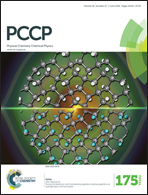A comparative study on the impact of different glymes and their derivatives as electrolyte solvents for graphite co-intercalation electrodes in lithium-ion and sodium-ion batteries†
Abstract
The abundance of sodium has recently sparked considerable interest in sodium-ion batteries (NIBs). Their similarity to conventional lithium-ion technology is obvious; however, the cell chemistry often significantly deviates. Graphite, although being the standard negative electrode in Li-ion batteries, is largely inactive for Na-ion storage in conventional non-aqueous carbonate-based electrolytes, for example. Very recently, it has been demonstrated that graphite can be activated for Na-ion storage in cells with ether-based electrolytes. The storage mechanism is based on co-intercalation of solvent molecules along with the Na-ions, forming ternary graphite intercalation compounds (t-GICs). This process is highly reversible but yet poorly understood. Here, we provide a comprehensive study on the formation and the stability of t-GICs. A series of ether solvents are being discussed: linear glymes with different chain lengths (mono-, di-, tri-, and tetraglyme), several derivatives with side groups as well as tetrahydrofuran (THF) as a cyclic ether and one crown ether. We show that the redox potentials shift depending on the ether chain length and mixing of ethers might enable tailoring of the redox behaviour. The inferior behaviour of triglyme is likely due to the less ideal ion coordination. Complementary experiments with lithium are made and demonstrate the superior behaviour of sodium. We find that the increase in graphene layer spacing during intercalation only slightly depends on the chain length and is in the range of 250%, and still mechanical stability is preserved. We further show the t-GICs possess chemical stability and demonstrate that the kinetically favoured charge transfer is probably due to the absence of a solid electrolyte interphase.


 Please wait while we load your content...
Please wait while we load your content...